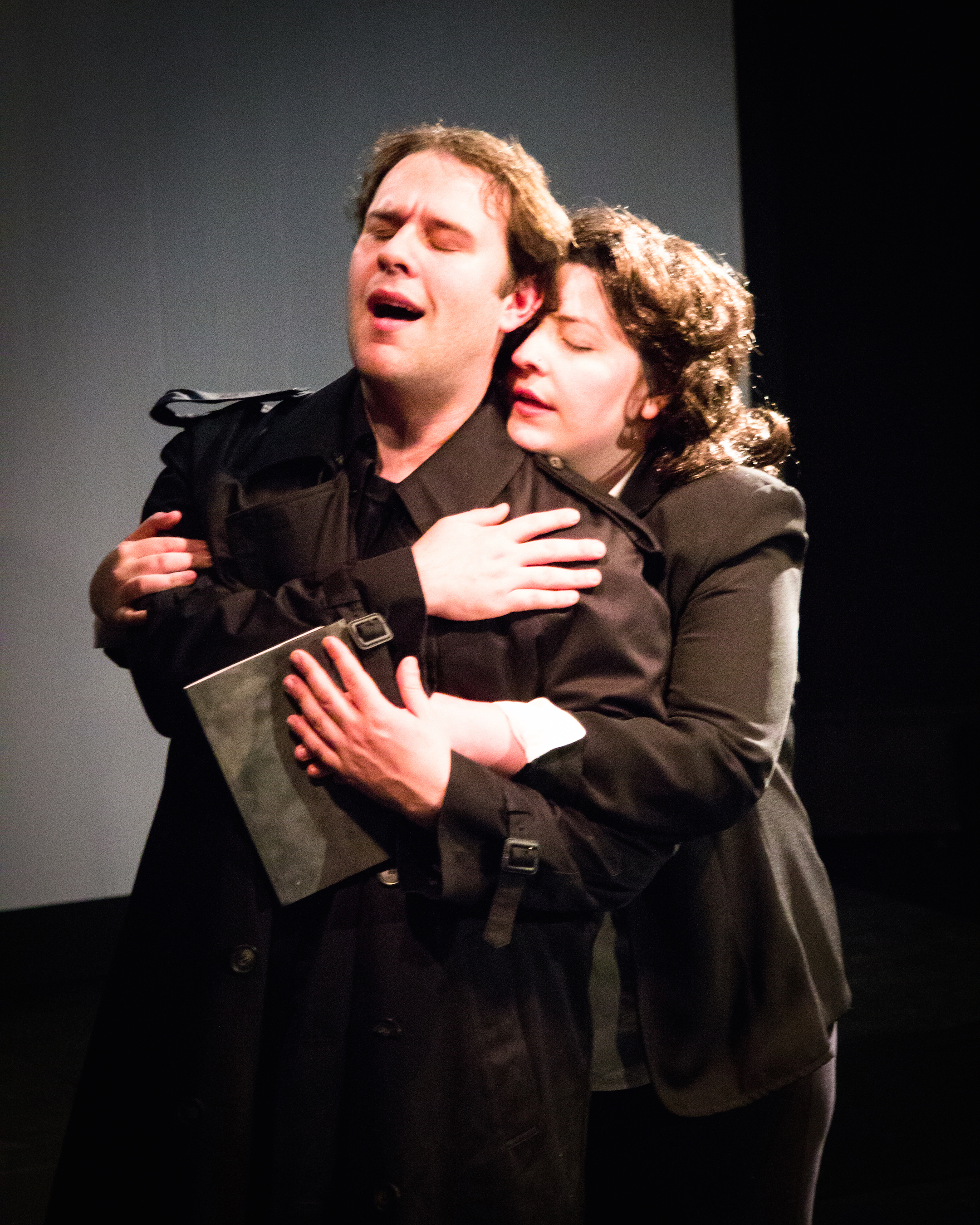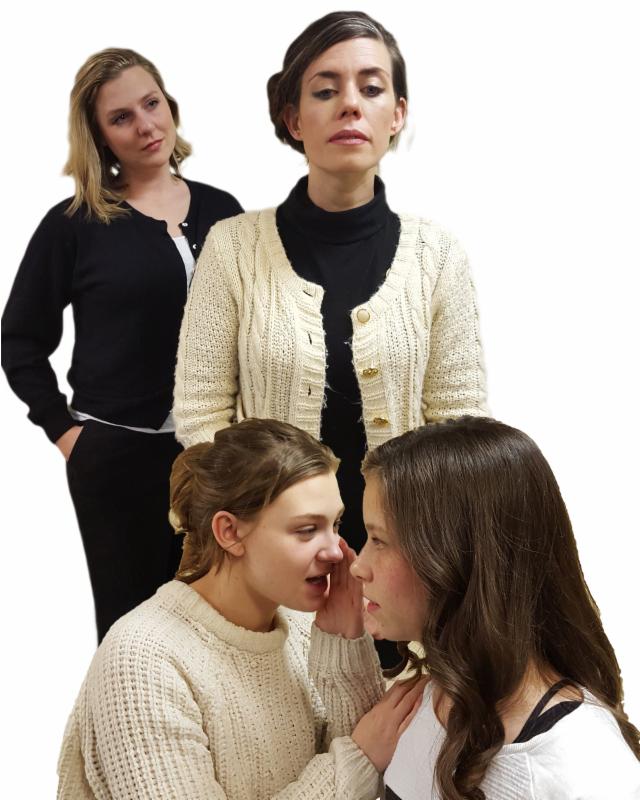Jon Becraft in Nobody Bunny in The Golden Age of Animation. Photo by Zachary Burrell Photography.
Nobody Bunny in The Golden Age of Animation
By Allie Keel
Directed by Gil Reyes
Review by Keith Waits
Entire contents copyright © 2018 by Keith Waits. All rights reserved
As a prelude to this play, vintage cartoons from the 1930’s were projected onstage as the audience entered to take their seats. Walt Disney’s Steamboat Willie, which introduced Mickey Mouse, was animated by Ub Iwerks, who (we are informed on titles between the shorts) soon left Disney to make his own cartoons for MGM, including Flip the Frog, an example of which followed hard upon. Before curtain, we were also treated to Betty Boop, and all of the cartoons were in stark black & white. Playwright Allie Keel identifies this period as the “Golden Age of Animation”, a time when the form was almost literally being invented. The end of the decade would bring Snow White, often described, somewhat inaccurately, as the first feature-length animated film. That it was in full color underscores the rapid development of the technology and the storytelling. However much the late 1940’s and 1950’s are celebrated for the rise of Disney’s commercial empire, Keel has chosen the most interesting and fertile period of animation creativity in which to set his story.
Charlie (Maxwell Williams) is the top animator for Ray Pilskin (Jake Minton) the unscrupulous studio chief who takes most of the credit for the Academy-Award winning cartoons, so Charlie leaves to work for Jack Palmer (Nick Hulstine), creating a new, enigmatic character named Nobody Bunny. Nobody becomes very popular, and Charlie falls for Palmer’s strong-willed secretary, Doris Billingsly (Jenn Ariadne Calvano).
That synopsis covers the play’s historical foundation, but Mr. Keel has also chosen to explore the nature of illusion in conflict with reality by manifesting Nobody Bunny as an actual character onstage, visible only to Charlie, a la Harvey, with not one, but four actors: Jon Becraft, Remy Sisk, Gracie Taylor, and Angela Williams portraying the character. Each seems intended to represent the different aspects of Charlie’s personality, and there is a very contemporary embrace of gender fluidity that suggests some confusion within Charlie’s identity. It is a whimsical device that touches upon the cultural preoccupation with fantasy. Charlie’s cartoons are filled with suggestive adult humor, which creates a crisis when the government imposed morality threatens Hollywood and the Hays office enforces the production code on all studio filmmaking. In one bravura scene late in the story, we witness Charlie’s creative process as he constructs a wild plotline for Nobody, aided by Sally Sing (Janelle Renee Dunn), who is another fictional cartoon creation from Charlie’s mind.
Nobody Bunny reaches back to a moment in time when the popular culture had not yet so fully embraced fantasy culture, before the unlimited narrative possibilities of comic books, before the lush dreamscapes of special effects in movies, before the obsessions that would lead to video games and the current Marvel Cinematic Universe which feels so in control of the box office as to choke off alternatives not grounded in illusion. It gives us a glimpse of these origins as assuredly as the death of Bruce Wayne’s parents or a teenager being bitten by a radioactive spider. It is nothing if not ambitious.
In truth, it may overreach. Keel is struggling with so many aspects of a wonderful and original idea that at times the play feels uneasy. I am not sure I can put my finger on exactly how, but it feels a little strained at times. By the end, it has found great focus, and the idea comes together nicely; enough resolution to be satisfying for the audience who doesn’t like loose ends, but with a deep subtext that leaves you actively thinking after you leave the theatre. I’ll take that over easily digested pap every day of the week.
Perhaps there are too many Nobody Bunnies, although I cannot fault the playing of any particular bunny. Jon Becraft was my favorite, bringing a Westbrook Van Voorhis style voice (March of Time newsreels) to the first Nobody that fits the period and establishes the snarky, mischievous edge to the character most effectively. Gracie Taylor also throws herself into the role with zeal as the femme fatale side of Nobody, while Remy Sisk seems to be the earnest and trusting heart of the character. By the time Angela Williams steps in, is it one too many? Ms. Williams also makes for an appealing cartoon figure, but is it a step too far?
Nobody Bunny is billed as “a world premiere workshop production”, so we might safely assume that the playwright has not reached the end of his journey with this script.
Sally Sing arrives rather late in the action, and Ms. Dunn gives her the innocent, sexy Betty Boop quality (she nails the voice) called for, and the character is crucial to unlocking the mystery of Charlie’s past and resolving the narrative.
Gil Reyes directs with an eye toward performance, and elicits daring physicality from much of the cast, in juxtaposition to the sharp delivery of the period dialogue. There is some nice use of shadow play, and some reasonably ingenious staging using limited props, and the look of the piece is largely defined by Campbell Childers’ costumes, which get the job done nicely enough. But the stage belongs to the actors, and they all deliver. Nick Hulstine is very good as the nicer studio chief, tough and hard-bitten but still compassionate. Jake Minton is basically the villain of the story, but neither Keel or Minton allow him to be one-dimensional. Ms. Calvano is a worldly female character, as wise and knowing as any of the men so that she evokes Jean Arthur or Rosalind Russell and reminds us that Hollywood used to know how to write for women.
Finally, Maxwell Williams builds the complex, nebbish center of the story with so much nice appreciation for all of the conflict within Charlie that he is always a compelling and accessible everyman, even, or perhaps exactly because, his dark side is given so much attention.
Nobody Bunny in the Golden Age of Animation is an easily engaging play because it is very funny, but it is in the way that it plumbs the depths of the human character that it distinguishes itself. Theatre [502] once again makes good on its commitment to new American plays by presenting a world premiere by a Louisville playwright with whom it has some history. That emphasis on the payoff of building and maintaining creative relationships is laudable, but also a healthy embrace of risk that is to always be encouraged.
Worth noting is the inclusion of the credits of an Intimacy Director, Alicia Rodis. Although only the language is explicit, the physical interactions between characters are at times intense, so credit to Theatre [502] for embracing the commitment to a safe and secure working environment for the cast and crew.
Nobody Bunny in The Golden Age of Animation
March 2, 3, 5, 9,10 @ 8:00pm
March 11 @ 2:00pm
Tickets $22.
Theatre [502]
The Baron’s Theatre
131 West Main Street
Louisville, KY 40202
theatre502.org
Keith Waits is a native of Louisville who works at Louisville Visual Art during the days, including being the host of LVA’s Artebella On The Radio on WXOX 97.1 FM / ARTxFM.com, but spends most of his evenings indulging his taste for theatre, music and visual arts. His work has appeared in Pure Uncut Candy, TheatreLouisville, and Louisville Mojo. He is now Managing Editor for Arts-Louisville.com.





